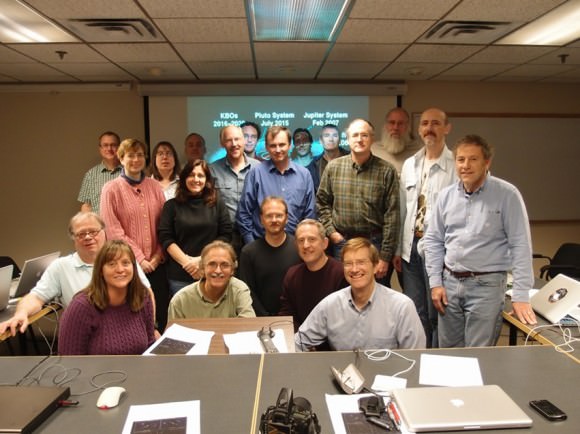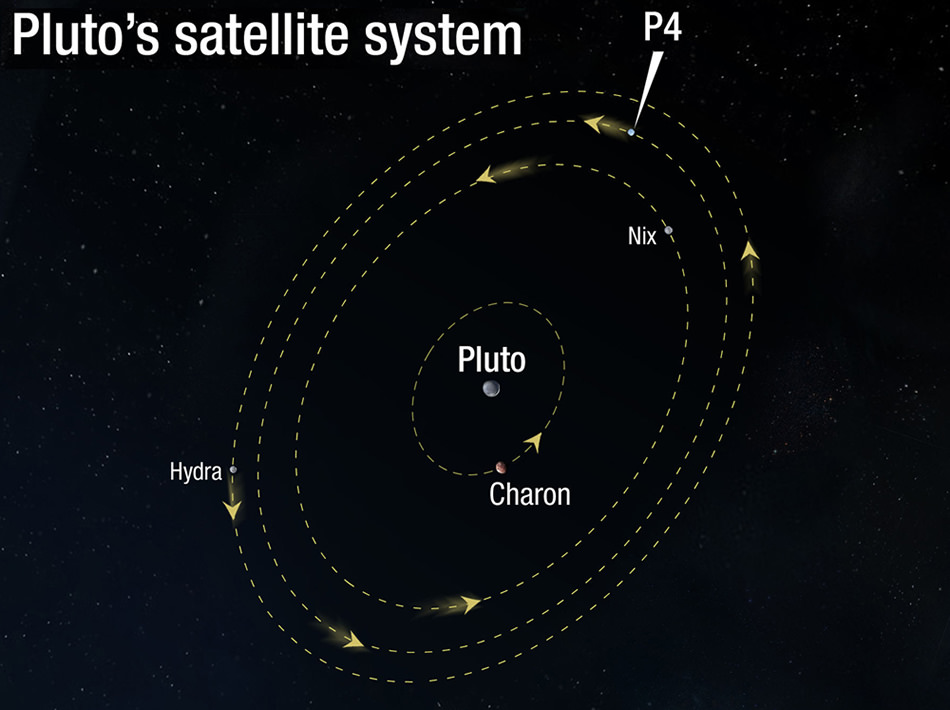[/caption]
With nearly two-thirds of its journey complete, the New Horizons spacecraft is still alive and well. It recently experienced a “hibernation wakeup” which started on November 5th and will last until November 15th… and it will sleep again until a month-long call in January. However, the real “wakeup call” may be when it reaches the complicated Pluto system. Watch out for that rock!
As more and more moons are discovered around Pluto, the higher the probability becomes of one of them – or debris surrounding them – could impact the delicate probe. With P4 discovered just a few short months ago, scientists are beginning to wonder just how many more are there which are too small and faint to be seen.
Says New Horizons Principal Investigator Alan Stern: “Even more worrisome than the possibility of many small moons themselves is the concern that these moons will generate debris rings, or even 3-D debris clouds around Pluto that could pose an impact hazard to New Horizons as it flies through the system at high speed. After all, at our 14-kilometer-per-second flyby speed, even particles less than a milligram can penetrate our micrometeoroid blankets and do a lot of damage to electronics, fuel lines and sensors.”
To enable research into what might be a prospective problem, the New Horizons team brought together about 20 of the world’s experts in ring systems, orbital dynamics and state-of-the-art astronomical observing techniques to search for small satellites and rings at distant Pluto. During a two day workshop, the group hashed and rehashed every possible scenario – including all the hazards that a small moon and debris-strewn system might cause.

“We found a plausible chance that New Horizons might face real danger of a killer impact; and that to mitigate that hazard, we need to undertake two broad classes of work.” said Stern. “First, we need to look harder at the Pluto system for still undiscovered satellites and rings. The best tools for this are going to be the Hubble Space Telescope, some very large ground-based telescopes, telescopes that can make stellar occultation observations of the space between Pluto and Charon where New Horizons is currently targeted, and thermal observations of the system by the ALMA radio telescope array just now being commissioned.”
The next step is planning – planning on a possible safer route through the Pluto system in the event that observations confirm navigational hazards. Studies presented at the Encounter Hazards Workshop show a good “safe haven bailout trajectory” (or SHBOT) could be designed to target a closest-approach aim point about 10,000 kilometers farther than the nominal mission trajectory. In this case, it would be a matter of aiming more towards Charon’s orbit, where the moon itself has cleared a path. However, even 180 degrees away on closest approach may not be enough. There’s always a chance of a debris field – one that doesn’t follow a plane, but has created a torus. In this event, material could be sailing along at speeds of up to 1-2 kilometers per second. Enough to annihilate delicate instruments.
“The question of whether the Pluto system could be hazardous to New Horizons remains open –but one we’ll be studying hard over the next year, with everything from computer models to big ground-based telescopes to the Hubble.” concludes Stern. “I’ll report on results as we obtain them, but it is not lost on us that there is a certain irony that the very object of our long-held scientific interest and affection may, after so many years of work to reach her, turn out to be less hospitable than other planets have been. We’ll see.”
Original Story Source: New Horizons News.


When they said that Pluto was no longer a planet, I had no idea that meant it was being re-designated as an interplanetary probe-killer!
Or as Pluto might say, “Revenge is sweet”
It has more moons than Earth, Mars, Venus and Mercury… but it’s not a planet folks…
It has more moons than Earth, Mars, Venus and Mercury… but it’s not a planet folks…
Neither Venus nor Mercury have moons.
Shhhh…
And many asteroids and Kuiper objects have moons.
And in principle moons can have temporary moons and so on; this reply is actually mooning the question all the way down.
Still it has more moons than Earth, Mars, Venus and Mercury together 🙂
What intrigues me is that all of them orbit Pluto in the same direction…do we know something about their spin orientation? I tought they were just captured by Pluto like Mars’ moons.
The Pluto-Charon system is, I recently discovered but haven’t followed up on, thought to be a result of the same impactor process that created the Earth-Moon and the Mars-satellites systems.
I see you refer to Mars’ moons as captured, but I believe that has been ruled out as too unlikely: same orbit direction, circular and equatorial orbits can’t be recreated by capture models. Conversely the deorbiting of Phobos and the discovery of several way elliptical impact scars around the equator is nicely predicted by impact-to-satellites models. (Only deorbiting satellites can create those impact remnants AFAIU.)
Presumably the other Pluto moons are similar to Deimos and Phobos in not having reassembled, while Charon is similar to Moon as having been. [Yo, Ivan, I need help with the sentence construction here!]
The Pluto-Charon system is, I recently discovered but haven’t followed up on, thought to be a result of the same impactor process that created the Earth-Moon and the Mars-satellites systems.
I see you refer to Mars’ moons as captured, but I believe that has been ruled out as too unlikely: same orbit direction, circular and equatorial orbits can’t be recreated by capture models. Conversely the deorbiting of Phobos and the discovery of several way elliptical impact scars around the equator is nicely predicted by impact-to-satellites models. (Only deorbiting satellites can create those impact remnants AFAIU.)
Presumably the other Pluto moons are similar to Deimos and Phobos in not having reassembled, while Charon is similar to Moon as having been. [Yo, Ivan, I need help with the sentence construction here!]
It is a dwarf planet. That seems like an extremely accurate description.
Who knew…amazing.
So this is the first mission that can be Nixed?
Reminds me of the close call of Pioneer 11 as it passed through the Saturnian system back in 1979.
From Wikipedia:
“Pioneer 11 imaged and nearly collided with one of Saturn’s small moons, passing at a distance of no more than 4,000 kilometers (2,500 mi). The object was tentatively identified as Epimetheus, a moon discovered the previous day from Pioneer’s imaging, and suspected from earlier observations by Earth-based telescopes. After the Voyager flybys, it became known that there are two similarly-sized moons (Epimetheus and Janus) in the same orbit, so there is some uncertainty about which one was the object of Pioneer’s near-miss. Pioneer 11 encountered Janus on September 1, 1979 at 14:52 UTC at a distance of 2500 km and Mimas at 16:20 UTC the same day at 103000 km.”
Hopefully no disastrous close calls befall New Horizons at Pluto!
New Horizons is going to zip by so quickly and the odds are still slim of an impact, so I say just let NH skim as close to Pluto as practical and get as many great photos of it and Charon as possible!
Yeah, Pluto ceased to be a planet, and now we must decide the criteria for what constitutes a MOON… maybe the potato circling Mars should be called something else… ha ha.
It has indeed been a discussion too AFAIK. Particularly here where the secondary body is so massive and the mutual center of gravity is outside the primary. The latter criteria has been used to strike the suggestion of Earth-Moon as a dual planet down (mutual center within Earth), but here it doesn’t apply.
Of course, since the new planet criteria removes as much of the ambiguity on planets as is possible, these old moon criteria definitions has been voided.
It has indeed been a discussion too AFAIK. Particularly here where the secondary body is so massive and the mutual center of gravity is outside the primary. The latter criteria has been used to strike the suggestion of Earth-Moon as a dual planet down (mutual center within Earth), but here it doesn’t apply.
Of course, since the new planet criteria removes as much of the ambiguity on planets as is possible, these old moon criteria definitions has been voided.
What a good idea it is to follow the path that Charon already cleared out.